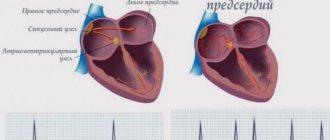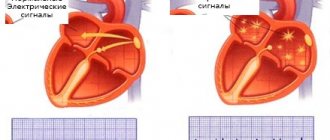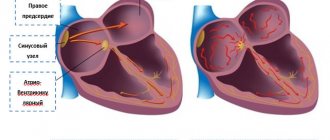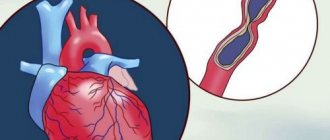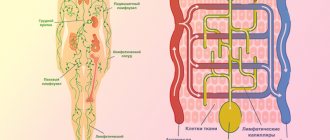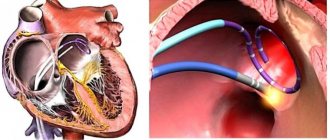Cardiac ablation: what is it?
Cardiac ablation is a procedure that can help correct arrhythmia, a problem with the rhythm of the heartbeat.
The procedure removes or leaves scars on the heart tissue that causes arrhythmia. There are several different types of cardiac ablation procedures. Each type helps treat different types of arrhythmia.
In this article, we will look at the different types of cardiac ablation surgeries, as well as their risks, preparation, recovery after surgery, and results.
Treatment methods
The main treatments for arrhythmia are drug therapy and surgery. Medicinal or conservative treatment consists mainly of taking vitamin-mineral complexes and restoratives. If the arrhythmia is more serious, antiarrhythmic drugs are prescribed. These are 4 groups of drugs, different in their method of action: sodium channel blockers, beta blockers, potassium channel blockers and calcium channel blockers.
Surgery
Surgical treatment is prescribed in more serious cases when there is a threat to the patient's life. This is the installation of a pacemaker or defibrillator. These are devices that are implanted under the patient's skin. They have electrodes that are inserted into pathological areas of the heart and generate impulses that initiate contraction of the heart muscles in the required rhythm.
Cardiac ablation: types
There are several types of cardiac ablation.
Catheter ablation
In this approach, surgeons insert long, thin tubes called catheters into blood vessels to destroy destructive cells in the heart.
Medical facilities use a variety of methods to remove cells that cause arrhythmia, including:
- radio frequency that creates heat
- freezing
Surgical ablation
Surgical ablation, also known as maze surgery or the Cox maze procedure, aims to eliminate atrial fibrillation (A-fib).
This is a form of open heart surgery that is often performed when surgery is being done for additional heart problems, such as valve replacement or heart bypass surgery.
The maze procedure involves making small incisions in the upper chambers of the heart, called the atria. This causes scar tissue to form, which blocks the electrical signals that cause A-fib.
Some people have minimally invasive surgery, the Cox maze procedure (also known as a mini-maze procedure), in which small incisions are made to reduce the risk of complications.
Hybrid surgical-catheter ablation
Hybrid surgical-catheter ablation combines catheter ablation, which treats the inside of the heart, with a mini-maze procedure, which treats the outer layer of the heart.
Advantages of radiofrequency ablation (RFA) over classical operations
RFA has a number of advantages compared to other radical methods of treating varicose veins:
- highest efficiency achieved through precise impact
- possibility of outpatient treatment
- painlessness of the method and easy tolerability of the procedure
- cosmetic effect (no incisions or stitches)
- no possibility of medical error when determining radiofrequency exposure settings
- the possibility of performing surgery in complex cases in the presence of trophic ulcers and skin induration
- short recovery period without serious lifestyle restrictions
- absence of negative manifestations after the procedure (hematomas, paresthesia, neuropathy)
- the possibility of combining RFA with other treatment methods to achieve maximum effect
- no complications
Why is cardiac ablation necessary?
Surgeons commonly use cardiac ablation to treat a number of conditions.
Supraventricular tachycardia (SVT)
SVT is the most common cause of surgical cardiac ablation. This is a condition in which the heart suddenly begins to beat much faster than its normal resting rate of 60–100 beats per minute. The electrical signal comes from the upper parts of the heart.
Atrial flutter
Atrial flutter is when the upper chambers of the heart beat very quickly due to improper transmission of electrical signals in the heart, often as a result of other heart problems such as coronary artery disease and high blood pressure.
Fibrillation
Fibrillation is a condition that causes irregular heartbeats in the upper chambers of the heart. This increases the risk of stroke and heart failure and can lead to an enlarged heart.
For fibrillation, a cardiac ablation procedure is often performed.
Other cardiac complications
Arrhythmia is also often a reason for cardiac ablation.
Radiofrequency catheter ablation of cardiac conduction tracts for tachyarrhythmias
Radiofrequency ablation (destruction) of cardiac conduction pathways is a minimally invasive method of radical treatment of tachycardia. A fairly young and effective method of minimally invasive treatment of tachycardia. This method is based on a local (point) effect of high-frequency electric current on the “center” of arrhythmia or a section of the circuit of circular motion of the pulse during tachycardias.
Symptoms (manifestations) of the disease:
- interruptions in heart function,
- attacks of tachycardia,
- episodes of weakness, dizziness, chest pain during an attack,
- loss of consciousness due to an attack
It is very important when a patient comes to the hospital for a consultation with a cardiac surgeon-arrhythmologist, the patient has an electrocardiogram with an attack of tachycardia, or an attack registered on the 24-hour electrocardiogram monitor.
To carry out the intervention, patients are hospitalized in the cardiology department of the hospital of St. Petersburg State Budgetary Healthcare Institution GB No. 40, before the operation it is necessary to perform a series of examinations and pass a list of necessary tests.
The operation is performed in an X-ray operating room (Department of X-ray endovascular diagnostics and treatment; Head: Candidate of Medical Sciences S.V. Vlasenko) under the constant supervision of an anesthesiologist and monitoring of blood pressure and electrocardiogram.
The procedure is performed by experienced x-ray surgeons-arrhythmologists A.V. Kamenev, Ph.D., A.M. Osadchim, electrophysiologists Ph.D., T.A. Lyubimtseva, M.A. Vander. The group works under the guidance of prof. RAS D.S. Lebedeva.
Procedure (operation) of catheter ablation for tachycardia.
Radiofrequency ablation usually does not require general anesthesia (anesthesia).
Immediately before ablation, an invasive electrophysiological study of the heart is performed to determine the mechanism of arrhythmia formation and its localization. It is carried out using diagnostic catheter-electrodes inserted through large veins (femoral, subclavian) or arteries, which make it possible to accurately determine the location of the “pathological focus” of arrhythmia.
Previously, under local anesthesia (“freezing”), hemostatic introducers (“tubes”) are introduced into these large vessels, which help protect the vessel.
Then, using a special “ablation” electrode, a search is carried out (“mapping” using the modern Carto 3 navigation system; Fig. 1.) and “cauterization” of the source of arrhythmia.
The electrodes are delivered to the heart and the procedure is performed under fluoroscopic control (Fig. 2).
The operation lasts from 45 to 150 minutes and it all depends on the location of the source of arrhythmia, quick search and its depth. As a rule, on the 1st-2nd day after surgery the patient can be discharged from the hospital.
| Figure 1. RFA of the focus of ventricular tachycardia during an electrical storm | Figure 2. Rg-freeze frame when performing RFA of a VT focus in the LV, transseptal approach |
Radiofrequency ablation of the arrhythmogenic zone can radically cure:
- Paroxysmal atrioventricular-nodal re-entry tachycardia.
- Paroxysmal atrioventricular reentrant tachycardia involving an accessory pathway (WPW syndrome).
- Paroxysmal form of typical atrial flutter.
- Paroxysmal form of atrial fibrillation (AF) with no effect from antiarrhythmic therapy (efficacy up to 92%).
- Persistent tachysystolic AF with ineffectiveness of drug therapy (the effectiveness of the first procedure is up to 67%).
- Paroxysmal atrial tachycardia.
- Ventricular monomorphic (from one focus) tachycardia.
- Ventricular monomoral extrasystole with clinical symptoms (frequent, more than 7-10 thousand/day).
Contraindications for catheter ablation for tachycardia:
- acute infectious diseases,
- acute myocardial infarction,
- unstable angina for 4 weeks,
- chronic heart failure III-IV f.k. according to NYHA,
- left ventricular aneurysm with thrombus,
- blood clots in the cavities of the heart,
- cardiac mechanical prostheses of the left chambers of the heart with access from the left.
When performing catheter ablation for arrhythmias, the rate of complications does not exceed 1%. In order to prevent the latter, all necessary measures are taken at all stages of diagnosis and treatment.
The advantages of this method are that it is minimally invasive (low-traumatic), as a rule, hospitalization does not take more than 3 days, patients quickly resume their normal lifestyle and rehabilitation does not take more than a week. Operations are performed under a quota (VMP) (for residents of St. Petersburg) and modern equipment and expensive consumables are used to perform them within the framework of funding from the federal budget.
| Radiologist consultations are carried out: on Wednesdays from 17:00 to 19:00, arrhythmologist on Thursdays from 15:00 to 17:00 in the rehabilitation building, 4th floor, room 424. Make an appointment with specialists by calling 200-16-88. Osadchiy Andrey Mikhailovich (surgeon-arrhythmologist) +7 (911) 126-36-64; Decoration in room No. 340 of clinic No. 68, third floor. Bring with you a referral for consultation from the clinic, a compulsory medical insurance policy, a passport and SNILS. If available, have medical documentation (early discharge notes, EchoCG, 24-hour ECG monitor, ECG with arrhythmia). |
← Back
Risks
Cardiac ablation is generally a low-risk procedure. However, risks vary depending on the type of treatment.
Catheter ablation
Catheter ablation is the least invasive approach and carries fewer risks than other procedures.
However, there is still the potential for damage to the heart, blood vessels, and nearby body parts, as well as destabilization of the heart's electrical system.
Hybrid surgical-catheter ablation
The operation, performed together with the insertion of a catheter, does not require artificial circulation. This is why this type of ablation is not as risky as others. However, there are still risks associated with catheter ablation.
Surgical ablation
Surgical ablation is a form of open heart surgery. This means that it includes all the risks associated with operations of this kind. Risks may include:
- bleeding
- stroke
- infection
- reaction to anesthetics
- potentially fatal heart damage
Radiofrequency ablation (RFA) - Wikipedia says that...
The RFA method is more appropriate for the treatment of both small and large veins with a lumen diameter of more than 15 mm. If the lumen of the vein is no more than 3 mm, then it is more advisable to use laser vein obliteration, since the light guide is slightly thinner than a radiofrequency catheter.
Radiofrequency ablation (RFA) of veins is technically difficult to perform even on vessels that have a pronounced bend or a special structure. However, in the small and great saphenous veins, which are most often subjected to radiofrequency “welding,” serious bends that impede the passage of the catheter are extremely rare.
Preparing for surgery
In general, the following steps are recommended before surgery:
- abstain from smoking 2 weeks before surgery
- abstaining from food and drink, even water, the night before the procedure
- do not use scented products such as lotions on the day of surgery
- Gather items to bring to the hospital, including relevant identification and insurance documents, a complete list of medications and supplements you take, and cases for storing glasses or dentures
You should consult your doctor for specific instructions for the type of surgery you are having.
Radiofrequency ablation (RFA) of lower extremity veins, complications
The RFA method is an automated process that eliminates excessive impact on the vein and through perforation. American and European phlebologists believe that the safest method of treating varicose veins at the moment is radiofrequency ablation (RFA). Photos of patients after the procedure confirm the absence of swelling and hematomas. There is no pain as such both during RFA and after it.
The only complication encountered during the development of this technique was deep vein thrombosis. However, such a serious complication was extremely rare. Various sources estimate the risk of thrombosis at 0.1-2%. Over the entire 10-year history of the use of radiofrequency ablation worldwide, only a few cases of thrombosis or thromboembolism of the pulmonary vessels have been recorded.
To avoid the formation of blood clots, the attending physician may prescribe low molecular weight heparins (Clexane or Fraxiparine) in prophylactic dosages from the day when radiofrequency ablation (RFA) of the veins of the lower extremities is performed. Reviews left by patients only sometimes indicate some discomfort. Unpleasant sensations are mild and pass quickly.
What to expect during surgery
Surgical experience varies greatly depending on the type of ablation.
Catheter ablation
Typically, catheter ablation lasts from 2 to 4 hours and takes place in a hospital or special laboratory. The patient usually remains conscious throughout the procedure, but is given intravenous medications to make them drowsy.
The surgeon inserts a catheter, usually through a clean and shaved groin area, and guides it toward the heart. There, the pulses destroy abnormal cells over an area of about one-fifth of an inch.
Hybrid surgical-catheter ablation
This approach involves two procedures that can be separated or performed during one hospital stay. During the operation, the surgeon will make small incisions in the chest and an electrophysiologist will perform catheter ablation.
Surgical ablation
Surgical ablation requires general anesthesia. In this procedure, surgeons cut the inside of the heart to create scar tissue to restore balance to the heart's electrical system.
In some cases, it may be necessary to spread the patient's ribs and place his heart on a heart-lung machine. However, not all operations are so complex.
Effectiveness of radiofrequency ablation of veins
Although radiofrequency ablation (RFA) of the veins of the lower extremities is recognized as the most effective and high-quality treatment for varicose veins, it does not exclude possible relapse of the disease. None of the modern methods will provide a complete cure for chronic venous insufficiency. However, the development of relapse after radiofrequency “brewing” of the main veins is practically impossible today.
Patients who have undergone radiofrequency ablation (RFA), whose reviews are posted on the Internet and on our website, are satisfied with the results of the operation. Patients note that their lifestyle and motor patterns remained virtually unchanged during the rehabilitation period, and this is very important in our time. Radiofrequency ablation (RFA) of veins, which is quite affordable, is the most effective, safe and fastest way to treat varicose veins around the world. The highly qualified staff of our clinic and high-quality equipment for performing RFA are the guarantee of excellent results.
Recovery and results
The nature of recovery after cardiac ablation surgery depends on the type of procedure.
Catheter ablation
This is usually an outpatient procedure. However, the patient will need to keep their legs straight for 6 to 8 hours before they can get out of bed, so most patients stay in the hospital overnight.
You can resume your normal activities the day after you return from the hospital. However, you should not drive or drink alcohol for 24 hours. You should also avoid strenuous exercise for about 3 days.
Hybrid surgical-catheter ablation
This procedure requires a hospital stay of 2–5 days and recovery takes about 2 weeks.
Surgical ablation
Surgical ablation requires a challenging healing process, requiring the patient to remain hospitalized for 5-7 days and have a 4-week recovery period.
During recovery, the patient should get plenty of rest and avoid lifting heavy objects.
You should also follow your doctor's instructions.
Cardiac ablation surgery is usually effective. However, patients may continue to have noticeable arrhythmias for several weeks. They may even require medication to control their symptoms.
Researchers report that catheter ablation surgery can successfully correct both short-term and long-term arrhythmias.
Although you can soon return to work and many other activities, it may take up to 3 months after catheter ablation for the body to adapt and the benefits of the procedure to become apparent.
Are there any restrictions after RFA?
Like any treatment technique, radiofrequency ablation imposes certain restrictions on the patient, but these restrictions are very few. First of all, rehabilitation after RFA includes mandatory wearing of compression stockings for 1-2 weeks. Thus, Intex postoperative compression stockings reduce swelling and help to virtually eliminate the risk of thromboembolism .
Indications
The technique is applicable in the case of diagnosing small single tumors or the presence of metastases in a number of organs:
- Liver;
- Kidneys;
- Lungs;
- Adrenal glands;
- Prostate;
- Skeletal system.
The technique is widely used for tumors that are inoperable or that are contraindicated to surgical manipulation and chemotherapy.
The technique is effective in localizing oncology on the mucous membranes of hollow organs in the initial stage.
The technique is also used to treat precancerous pathologies, cardiac arrhythmias, varicose veins, etc.
Access paths
The procedure requires access to the tissue of interest. There are several options for such access:
- Transdermal option. The probe is inserted through a puncture or a minimal skin incision;
- Endoscopic option. Suitable for cancer of the lungs, larynx, esophagus, stomach, bladder, cervix, and some others;
- Laparoscopic option. Used for oncology of the liver, pancreas, prostate, uterus, ovaries;
- Surgical option. Essentially, this is an additional exposure during surgery.
Contraindications for RFA
The operation has no absolute contraindications: radiofrequency catheter ablation is performed for arrhythmia and other pathologies listed above, even in the elderly and children. However, RFA is undesirable for such pathologies as:
- serious condition of the patient;
- inflammation in the heart;
- kidney dysfunction;
- respiratory failure;
- pregnancy;
- blood clotting pathologies;
- advanced arterial hypertension;
- elevated temperature;
- stage of active endocarditis;
- blood clots in the heart;
- high blood pressure.
Patient reviews
Ekaterina_V
“RFA was prescribed after a severe attack of arrhythmia, I waited a long time for the operation, and underwent endless examinations. The preparatory period turned out to be more difficult than the operation itself - I lay motionless for 2 hours, and after a few days I was already at home. I’ve been feeling great for six months now, I regularly visit a cardiologist, and follow all his recommendations.”
Dashylya
“I had RFA 2 months ago, the source of the arrhythmia could not be found for a long time, throughout the operation I was bothered by unpleasant sensations in the sternum, there were constant rhythm fluctuations. A repeat ECG showed atrial fibrillation, the condition has worsened, now I’m taking a bunch of medications, preparing for a new operation.”
Alexey_59
“I had my heart cauterized 2 years ago. Immediately after RFA, there was a slight bleeding at the puncture site, and I suffered from rare attacks of arrhythmia for several months - that’s all the consequences of the operation.”
Reviews from cardiologists
Simonov Pavel Olegovich, cardiologist
“RFA of the heart is one of the most modern methods of treating atrial fibrillation, atrial and ventricular tachycardia. The operation has a small number of contraindications, complications occur in only 1% of patients, and the benefits of the intervention are beyond doubt - people quickly disappear from symptoms that cause discomfort, and the risk of developing vascular accidents is significantly reduced.”
RFA is a minimally invasive operation in which no incisions are made, and there are no significant and noticeable scars left at the puncture sites. Most patients of all ages tolerate ablation well; all discomfort disappears within a week. If a person reconsiders his usual lifestyle and adheres to a reasonable diet, then repeated intervention will not be required.
Possible consequences and complications
Negative consequences after RFA rarely occur; bleeding and suppuration of the skin at the puncture sites are most often observed.
Possible complications:
- endocarditis is an inflammatory process in the internal heart cavity;
- the formation of blood clots due to a violation of the integrity of blood vessels;
- disturbances in heart rhythm;
- perforation by a probe, catheter of the heart wall, artery;
- venous stenosis;
- renal dysfunction.
Negative consequences of surgery often occur in people with chronic diseases, diabetes, poor blood clotting, failure to follow the rules of preoperative preparation, or violation of doctor’s recommendations during rehabilitation.

